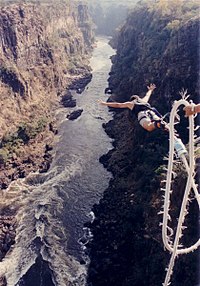
Photo from wikipedia
Urban tourism has been suffering socio-economic challenges from flood inundation risk (FIR) triggered by extraordinary rainfall under climate extremes. The evaluation of FIR is essential for mitigating economic losses, and… Click to show full abstract
Urban tourism has been suffering socio-economic challenges from flood inundation risk (FIR) triggered by extraordinary rainfall under climate extremes. The evaluation of FIR is essential for mitigating economic losses, and even casualties. This study proposes an innovative spatial framework integrating improved k-nearest neighbor (kNN), remote sensing (RS), and geographic information system (GIS) to analyze FIR for tourism sites. Shanghai, China, was selected as a case study. Tempo-spatial factors, including climate, topography, drainage, vegetation, and soil, were selected to generate several flood-related gridded indicators as inputs into the evaluation framework. A likelihood of FIR was mapped to represent possible inundation for tourist sites under a moderate-heavy rainfall scenario and extreme rainfall scenario. The resultant map was verified by the maximum inundation extent merged by RS images and water bodies. The evaluation outcomes deliver the baseline and scientific information for urban planners and policymakers to take cost-effective measures for decreasing and evading the pressure of FIR on the sustainable development of urban tourism. The spatial improved-kNN-based framework provides an innovative, effective, and easy-to-use approach to evaluate the risk for the tourism industry under climate change.
Journal Title: Sustainability
Year Published: 2021
Link to full text (if available)
Share on Social Media: Sign Up to like & get
recommendations!